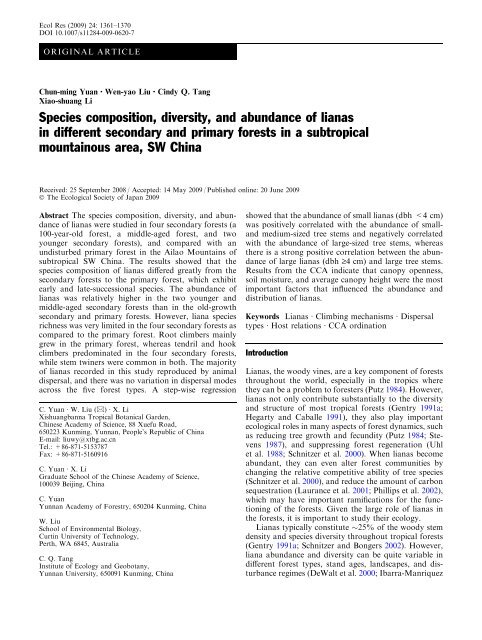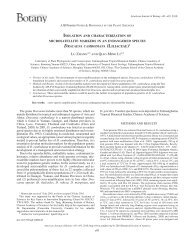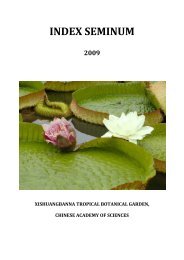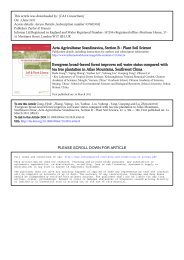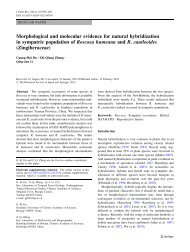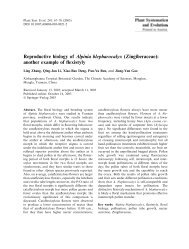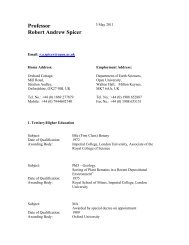Species composition, diversity, and abundance of lianas in different ...
Species composition, diversity, and abundance of lianas in different ...
Species composition, diversity, and abundance of lianas in different ...
- No tags were found...
Create successful ePaper yourself
Turn your PDF publications into a flip-book with our unique Google optimized e-Paper software.
Ecol Res (2009) 24: 1361–1370DOI 10.1007/s11284-009-0620-7ORIGINAL ARTICLEChun-m<strong>in</strong>g Yuan Æ Wen-yao Liu Æ C<strong>in</strong>dy Q. TangXiao-shuang Li<strong>Species</strong> <strong>composition</strong>, <strong>diversity</strong>, <strong>and</strong> <strong>abundance</strong> <strong>of</strong> <strong>lianas</strong><strong>in</strong> <strong>different</strong> secondary <strong>and</strong> primary forests <strong>in</strong> a subtropicalmounta<strong>in</strong>ous area, SW Ch<strong>in</strong>aReceived: 25 September 2008 / Accepted: 14 May 2009 / Published onl<strong>in</strong>e: 20 June 2009Ó The Ecological Society <strong>of</strong> Japan 2009Abstract The species <strong>composition</strong>, <strong>diversity</strong>, <strong>and</strong> <strong>abundance</strong><strong>of</strong> <strong>lianas</strong> were studied <strong>in</strong> four secondary forests (a100-year-old forest, a middle-aged forest, <strong>and</strong> twoyounger secondary forests), <strong>and</strong> compared with anundisturbed primary forest <strong>in</strong> the Ailao Mounta<strong>in</strong>s <strong>of</strong>subtropical SW Ch<strong>in</strong>a. The results showed that thespecies <strong>composition</strong> <strong>of</strong> <strong>lianas</strong> differed greatly from thesecondary forests to the primary forest, which exhibitearly <strong>and</strong> late-successional species. The <strong>abundance</strong> <strong>of</strong><strong>lianas</strong> was relatively higher <strong>in</strong> the two younger <strong>and</strong>middle-aged secondary forests than <strong>in</strong> the old-growthsecondary <strong>and</strong> primary forests. However, liana speciesrichness was very limited <strong>in</strong> the four secondary forests ascompared to the primary forest. Root climbers ma<strong>in</strong>lygrew <strong>in</strong> the primary forest, whereas tendril <strong>and</strong> hookclimbers predom<strong>in</strong>ated <strong>in</strong> the four secondary forests,while stem tw<strong>in</strong>ers were common <strong>in</strong> both. The majority<strong>of</strong> <strong>lianas</strong> recorded <strong>in</strong> this study reproduced by animaldispersal, <strong>and</strong> there was no variation <strong>in</strong> dispersal modesacross the five forest types. A step-wise regressionC. Yuan Æ W. Liu (&) Æ X. LiXishuangbanna Tropical Botanical Garden,Ch<strong>in</strong>ese Academy <strong>of</strong> Science, 88 Xuefu Road,650223 Kunm<strong>in</strong>g, Yunnan, People’s Republic <strong>of</strong> Ch<strong>in</strong>aE-mail: liuwy@xtbg.ac.cnTel.: +86-871-5153787Fax: +86-871-5160916C. Yuan Æ X. LiGraduate School <strong>of</strong> the Ch<strong>in</strong>ese Academy <strong>of</strong> Science,100039 Beij<strong>in</strong>g, Ch<strong>in</strong>aC. YuanYunnan Academy <strong>of</strong> Forestry, 650204 Kunm<strong>in</strong>g, Ch<strong>in</strong>aW. LiuSchool <strong>of</strong> Environmental Biology,Curt<strong>in</strong> University <strong>of</strong> Technology,Perth, WA 6845, AustraliaC. Q. TangInstitute <strong>of</strong> Ecology <strong>and</strong> Geobotany,Yunnan University, 650091 Kunm<strong>in</strong>g, Ch<strong>in</strong>ashowed that the <strong>abundance</strong> <strong>of</strong> small <strong>lianas</strong> (dbh
1362<strong>and</strong> Mart<strong>in</strong>ez-Ramos 2002; Reddy <strong>and</strong> Parthasarathy2003; Parthasarathy et al. 2004; DeWalt et al. 2006).Trellis availability <strong>and</strong> tree architecture together <strong>in</strong>fluencethe distribution <strong>of</strong> <strong>lianas</strong> <strong>in</strong> the forests (Putz 1984;Balfour <strong>and</strong> Bond 1993). The <strong>abundance</strong> <strong>and</strong> species<strong>diversity</strong> <strong>of</strong> <strong>lianas</strong> also depend upon several key abioticfactors, <strong>in</strong>clud<strong>in</strong>g total ra<strong>in</strong>fall, seasonality <strong>of</strong> ra<strong>in</strong>fall,soil fertility <strong>and</strong> disturbance (Schnitzer <strong>and</strong> Bongers2002; Schnitzer 2005). Especially, forest disturbance canpromote the proliferation <strong>of</strong> <strong>lianas</strong> because it can<strong>in</strong>crease their establishment opportunity by alter<strong>in</strong>g thelight environments <strong>and</strong> provid<strong>in</strong>g suitable trellises forclimb<strong>in</strong>g (Putz 1984; Schnitzer <strong>and</strong> Bongers 2002). Thisimplies that <strong>lianas</strong> will <strong>in</strong>crease <strong>in</strong> importance withgrow<strong>in</strong>g rates <strong>of</strong> forest disturbance. Currently, thecommunity <strong>of</strong> <strong>lianas</strong> has been well documented, primarily<strong>in</strong> disturbed forests (Uhl et al. 1988; Chittibabu<strong>and</strong> Parthasarathy 2001; Reddy <strong>and</strong> Parthasarathy 2003;Rice et al. 2004) or <strong>in</strong> primary forests (e.g., Putz <strong>and</strong>Chai 1987; Appanah et al. 1993), while contrasts amongthe liana communities <strong>in</strong> secondary <strong>and</strong> primary forestsare rarely studied (DeWalt et al. 2000).DeWalt et al. (2000) analyzed the changes <strong>in</strong> <strong>lianas</strong>pecies <strong>and</strong> density along a forest chronosequence <strong>in</strong>central Panama, <strong>and</strong> found that the density <strong>and</strong> <strong>diversity</strong><strong>of</strong> <strong>lianas</strong> decreased with the progress <strong>of</strong> secondary succession.They supposed that the pattern may be relatedto the <strong>in</strong>creased tree diameter, canopy height, <strong>and</strong>decreased light levels <strong>in</strong> the course <strong>of</strong> forest succession.However, the relationships between <strong>lianas</strong> <strong>and</strong> foreststructural <strong>and</strong> environmental variables are still poorlyunderstood. Greater underst<strong>and</strong><strong>in</strong>g <strong>of</strong> the divergentpatterns <strong>of</strong> <strong>lianas</strong> <strong>in</strong> secondary to primary forests couldfurther our knowledge <strong>of</strong> the dynamics <strong>of</strong> forests.In this study, the major objective is to describe thepatterns <strong>of</strong> liana communities <strong>in</strong> four secondary forests(a 100-year-old forest, a middle-aged forest, <strong>and</strong> twoyounger secondary forests), <strong>and</strong> to compare them withan undisturbed moist evergreen broad-leaved primaryforest <strong>in</strong> the Ailao Mounta<strong>in</strong>s <strong>of</strong> SW Ch<strong>in</strong>a. Specifically,we exam<strong>in</strong>ed: (1) the vary<strong>in</strong>g species <strong>composition</strong> <strong>of</strong><strong>lianas</strong>; (2) the vary<strong>in</strong>g <strong>diversity</strong>, <strong>abundance</strong>, basal area,<strong>and</strong> size-class distribution <strong>of</strong> liana communities; (3) thecontrasts among <strong>different</strong> climb<strong>in</strong>g guilds <strong>and</strong> dispersalmodes <strong>of</strong> <strong>lianas</strong> <strong>in</strong> the five forests. Another objective isto exam<strong>in</strong>e the relationships between <strong>lianas</strong> <strong>and</strong> structural<strong>and</strong> environmental variables <strong>of</strong> the <strong>different</strong> secondary<strong>and</strong> primary forests.MethodsStudy siteThe field study was conducted <strong>in</strong> the Xujiaba region <strong>of</strong>SW Ch<strong>in</strong>a, which is 2,000–2,650 m a.s.l. on the northerncrest <strong>of</strong> the Ailao Mounta<strong>in</strong>s National Nature Reserve(23°35¢–24°44¢N, 100°54¢–100°30¢E; Fig. 1). Located onthe upper parts <strong>of</strong> the Ailao Mounta<strong>in</strong>s, the Xujiabaregion is the ma<strong>in</strong> part <strong>of</strong> the Ailao Mounta<strong>in</strong>s NationalNature Reserve, with an area <strong>of</strong> about 5,100 ha. At theAilao Mounta<strong>in</strong>s Forest Ecosystem Research Station(24°32¢N, 101°01¢E), annual mean precipitation <strong>in</strong> 1991–1995 averaged 1,931.1 mm, <strong>of</strong> which 85.0% occurreddur<strong>in</strong>g the ra<strong>in</strong>y season from May until October. Theaverage monthly temperature was 11.3°C, with averagemonthly m<strong>in</strong>imum <strong>and</strong> maximum temperatures <strong>of</strong> 5.4<strong>and</strong> 16.4°C <strong>in</strong> January <strong>and</strong> July, respectively (Qiu <strong>and</strong>Xie 1998; Fig. 1). Yellow-brown soils are distributed ascont<strong>in</strong>uous belts <strong>in</strong> the study area (Qiu <strong>and</strong> Xie 1998).The predom<strong>in</strong>ant vegetation <strong>in</strong> the region is the midmontanemoist evergreen broad-leaved primary forest(henceforth PF), which accounts for nearly 80% <strong>of</strong> thetotal area (Qiu <strong>and</strong> Xie 1998). The PF consists <strong>of</strong> tropical<strong>and</strong> temperate, some <strong>of</strong> them endemics. Canopyspecies ma<strong>in</strong>ly <strong>in</strong>clude Castanopsis wattii, Lithocarpusxylocarpus, Schima noronhae, L. j<strong>in</strong>gdongensis, <strong>and</strong>Hartia s<strong>in</strong>ensis (Tang et al. 2007). A reservoir constructedsome 100 years ago for rice irrigation onmounta<strong>in</strong>sides occupies the <strong>in</strong>terior <strong>of</strong> Xujiaba. Somesurround<strong>in</strong>g forested areas were cut when the reservoir<strong>and</strong> dam were built. Four secondary forests were formedafter severe disturbances by human. The old-growth oaksecondary forest (henceforth OOS) represents the advancednatural succession after clear-cutt<strong>in</strong>g follow<strong>in</strong>gfires <strong>and</strong> logg<strong>in</strong>g about 100 years ago (Young <strong>and</strong>Herwitz 1995). The middle-aged oak secondary forest(henceforth MOS) around the Xujiaba reservoir developedafter deforestation dur<strong>in</strong>g rebuild<strong>in</strong>g <strong>of</strong> the reservoir<strong>in</strong> the late 1950s (He et al. 2003). Both <strong>of</strong> the oakregrowth forests were ma<strong>in</strong>ly comprised <strong>of</strong> L. j<strong>in</strong>gdongensis<strong>and</strong> L. xylocarpus, but there were significant differences<strong>in</strong> floristics <strong>and</strong> structure (Young et al. 1992;Heet al. 2003). The Populus botanii secondary forest(henceforth PBS) <strong>and</strong> Alnus nepalensis secondary forest(henceforth ANS), patchily distributed at the edges <strong>of</strong>the primary forest, also resulted from repeated cutt<strong>in</strong>g,fires, <strong>and</strong> graz<strong>in</strong>g, but have been well protected s<strong>in</strong>ce thefoundation <strong>of</strong> the nature reserve <strong>in</strong> the late 1980s. ThePBS is ma<strong>in</strong>ly comprised <strong>of</strong> pioneer P. botanii <strong>and</strong>associated with other hardwood species, such as L. xylocarpus,L. j<strong>in</strong>gdongensis <strong>and</strong> L. pachyphyllus, which<strong>in</strong>dicates the successional trend toward the evergreenbroad-leaved forest. The ANS is dom<strong>in</strong>ated by a s<strong>in</strong>glepioneer tree species-A. nepalensis. These two secondaryforests can be described as the first stage <strong>of</strong> thesecondary succession to the oak secondary forest, <strong>and</strong>f<strong>in</strong>ally to the evergreen broad-leaved forest <strong>in</strong> this area(Wang 1983; Qiu <strong>and</strong> Xie 1998).Data collectionThe fieldwork was carried out between April <strong>and</strong> May,2006. Ten 20 · 20 m sample plots, <strong>of</strong> similar topography(valleys or lower slopes), were established <strong>in</strong> each <strong>of</strong>the four secondary <strong>and</strong> primary forests, <strong>and</strong> those <strong>lianas</strong><strong>of</strong> ‡2.0 m <strong>in</strong> length (from the roots) <strong>and</strong> ‡0.5 cm
1363Fig. 1 Location <strong>of</strong> the studyarea on the northern crest <strong>of</strong> theAilao Mounta<strong>in</strong>s NationalNature Reserve, southwesternCh<strong>in</strong>a, <strong>and</strong> climate diagramfrom the Ailao Mounta<strong>in</strong>sForest Ecosystem ResearchStation from 1991 to1995 (Qiu<strong>and</strong> Xie 1998)diameter at breast height (dbh) were counted. Lianaswere def<strong>in</strong>ed as woody climb<strong>in</strong>g plants permanentlyrooted <strong>in</strong> the ground, hemi-epiphytes <strong>and</strong> strangersbe<strong>in</strong>g excluded. We recorded liana species, dbh (1.3 malong the stem from the roots), climb<strong>in</strong>g mechanisms,life forms (i.e., evergreen vs. deciduous), <strong>and</strong> <strong>abundance</strong>.The <strong>abundance</strong> <strong>of</strong> <strong>lianas</strong> was the number <strong>of</strong> <strong>in</strong>dividuals<strong>in</strong> the sampl<strong>in</strong>g plots. An <strong>in</strong>dividual was def<strong>in</strong>ed as an<strong>in</strong>dependent liana (genet) that was not connected aboveground or obviously connected below ground to anyother stem <strong>in</strong>cluded <strong>in</strong> the census (follow<strong>in</strong>g Schnitzeret al. 2000; Gerw<strong>in</strong>g et al. 2006). When it was unclearwhether stems were connected below ground, they weretreated as dist<strong>in</strong>ct <strong>in</strong>dividuals (DeWalt et al. 2000). If as<strong>in</strong>gle liana <strong>in</strong>dividual had multiple vegetative <strong>of</strong>fshoots(ramets) connected to the ma<strong>in</strong> stem, we <strong>in</strong>cluded onlythe largest diameter stem.The <strong>lianas</strong> encountered were categorized as follows:(1) stem tw<strong>in</strong>ers, (2) hook climbers, (3) root climbers,<strong>and</strong> (4) tendril climbers, based on observations <strong>in</strong> thefield <strong>and</strong> with reference to Putz (1984). We assigned adispersal mode to each species accord<strong>in</strong>g to the traits <strong>of</strong>its seeds <strong>and</strong> fruits (Solorzano et al. 2002), either by fieldobservation or by consult<strong>in</strong>g regional floras. In thisstudy, three dispersal types are classified: anemochory(w<strong>in</strong>d-dispersed fruits or seeds with plumose appendagesor scarious w<strong>in</strong>g-like appendages), zoochory (animaldispersedfruits with s<strong>of</strong>t <strong>and</strong> fleshy outer layers or seedswith arils), <strong>and</strong> autochory (active seed dispersal by theplant itself, usually by explosive dehiscence, such asexplosive pods).To describe the structure <strong>of</strong> the forest communities,all stems <strong>in</strong>clud<strong>in</strong>g ma<strong>in</strong> stems <strong>and</strong> sprouts ‡1 cm <strong>in</strong> dbhwere measured for all tree <strong>and</strong> shrub species present <strong>in</strong>each plot, <strong>and</strong> average canopy height <strong>of</strong> each plot wasdeterm<strong>in</strong>ed us<strong>in</strong>g a cl<strong>in</strong>ometer.Altitude <strong>and</strong> degree <strong>of</strong> canopy openness were alsorecorded for each plot. Altitude was the average <strong>of</strong> fivemeasurements taken <strong>in</strong> the same plot, us<strong>in</strong>g an altimeter.Canopy openness was measured us<strong>in</strong>g the Crown Illum<strong>in</strong>ationEllipse Index (CIE value 1.0, 1.5, 2.0, 2.5, 3.0,4.0 <strong>and</strong> 5.0) as described <strong>in</strong> Brown et al. (2000). Five soilcores (8 cm <strong>in</strong> diameter · 15 cm <strong>in</strong> depth) were r<strong>and</strong>omlytaken <strong>in</strong> each plot to assess the soil moisturecontent by the gravimetric method. Soil samples weredried at 105°C to constant weight (dry weight) <strong>in</strong> thelaboratory. Soil moisture content (SM) was expressed aspercentage <strong>of</strong> dry weight: SM = (ww dw)/dw · 100,where ww <strong>and</strong> dw represent the wet <strong>and</strong> dry weight,respectively.Data analysis<strong>Species</strong> <strong>diversity</strong> <strong>in</strong>dices among liana communities<strong>in</strong>clud<strong>in</strong>g the Shannon–Wiener <strong>in</strong>dex, Simpson’s <strong>in</strong>dex,<strong>and</strong> the Pielou evenness <strong>in</strong>dex (Magurran 1988) werecomputed <strong>in</strong> each plot <strong>of</strong> the four secondary <strong>and</strong> primaryforests. The differences <strong>in</strong> <strong>diversity</strong>, <strong>abundance</strong>,basal area, <strong>and</strong> size-class distribution <strong>of</strong> <strong>lianas</strong> <strong>in</strong> <strong>different</strong>forests were tested us<strong>in</strong>g one-way analysis <strong>of</strong>variance (ANOVA) <strong>in</strong> the SPSS version 13.0 (SPSS2004). The differences <strong>of</strong> the number <strong>of</strong> families, species,<strong>and</strong> <strong>in</strong>dividuals among <strong>different</strong> dispersal types weretested by v 2 test.The tree stems <strong>in</strong> the 50 plots were categorized as small(1 cm £ dbh < 8 cm), medium (8 cm £ dbh < 32cm), <strong>and</strong> large (dbh ‡ 32 cm). We analyzed the relativeeffect <strong>of</strong> the <strong>abundance</strong> <strong>of</strong> the three size-classes on liana<strong>abundance</strong> <strong>of</strong> total, small (dbh < 4 cm) <strong>and</strong> large(dbh ‡ 4 cm) size-classes at the same plot by conduct<strong>in</strong>g astepwise regression analysis us<strong>in</strong>g SPSS version 13.0.
1364Canonical correspondence analysis (CCA) was usedto analyze patterns <strong>of</strong> variation <strong>in</strong> liana distribution asdeterm<strong>in</strong>ed by the environmental variables recorded,us<strong>in</strong>g PC-ORD for W<strong>in</strong>dows V.4.01. Liana species withless than five <strong>in</strong>dividuals <strong>in</strong> the 50 sampl<strong>in</strong>g plots wereremoved <strong>in</strong> the CCA analysis.Results<strong>Species</strong> <strong>composition</strong>We recorded a total <strong>of</strong> 1,610 <strong>in</strong>dividual <strong>lianas</strong> ‡0.5 cmdiameter <strong>in</strong> the 50 sample plots, represent<strong>in</strong>g 33 species <strong>in</strong>26 genera <strong>and</strong> 17 families (Table 1). The families show<strong>in</strong>gthe most <strong>diversity</strong> <strong>in</strong> terms <strong>of</strong> the number <strong>of</strong> species werethe Rosaceae (6), Smilacaceae (4), <strong>and</strong> Papilionaceae (4).The most abundant families <strong>in</strong> terms <strong>of</strong> the number <strong>of</strong><strong>in</strong>dividuals was Rosaceae (44.7% <strong>of</strong> the total), followedby Smilacaceae (21.7%). In spite <strong>of</strong> be<strong>in</strong>g a relatively richspecies, Papilionaceae were poorly represented <strong>in</strong> terms <strong>of</strong><strong>in</strong>dividuals (3.3% <strong>of</strong> the total).The species <strong>composition</strong> <strong>of</strong> <strong>lianas</strong> differed greatlyamong the <strong>different</strong> secondary <strong>and</strong> primary forests(Table 1). Fourteen species were recorded <strong>in</strong> only one <strong>of</strong>the five forest sites, <strong>in</strong>clud<strong>in</strong>g Marsdenia tsaiana, Euonymusvagans, Hydrangea anomala, Schizophragma <strong>in</strong>tegrifolium,Gardneria lanceolata, Kadsura cocc<strong>in</strong>ea, <strong>and</strong>Schis<strong>and</strong>ra henryi <strong>in</strong> PF, Aristolochia kunm<strong>in</strong>gsis <strong>in</strong>MOS, Sabia schumanniana <strong>in</strong> PBS, <strong>and</strong> Apios carnea,Pueraria peduncularis, P. lobata, Rubus ellipticus <strong>and</strong>R. idaeus <strong>in</strong> ANS. Just four species occurred <strong>in</strong> all thefive forest sites, <strong>and</strong> other species were represented <strong>in</strong>two (five species), three (seven species), or four (threespecies) forest sites. The commonest families <strong>in</strong> the foursecondary forests, <strong>in</strong> terms <strong>of</strong> number <strong>of</strong> <strong>in</strong>dividuals,were Rosaceae <strong>and</strong> Smilacaceae (51.2–95.3% <strong>of</strong> thetotal), while <strong>in</strong> PF Vitaceae <strong>and</strong> Rosaceae predom<strong>in</strong>ated(56.9% <strong>of</strong> the total). The most abundant species <strong>in</strong> PFwas Parthenocissus himalayana, whereas it was RosaTable 1 List <strong>of</strong> <strong>lianas</strong> <strong>of</strong> dbh ‡0.5 cm <strong>and</strong> height ‡2.0 m as counted <strong>in</strong> 50 sampled plots measur<strong>in</strong>g 20 m · 20 m <strong>in</strong> <strong>different</strong> secondary<strong>and</strong> primary forests <strong>in</strong> the Ailao Mounta<strong>in</strong>sFamily <strong>Species</strong> <strong>Species</strong>codesCT DT LF No.<strong>of</strong> <strong>lianas</strong>Forest typePF OOS MOS PBS ANSAct<strong>in</strong>idiaceae Act<strong>in</strong>idia callosa ACCA ST Z D 39 18 5 16Aristolochiaceae Aristolochia kunm<strong>in</strong>gsis ARKU ST AN E 1 1Asclepiadaceae Marsdenia tsaiana MATS ST AN E 2 2Caprifoliaceae Lonicera japonica LOJA ST Z E 4 2 2Celastraceae Celastrus angulatus CEAN ST Z D 66 8 17 32 3 6Euonymus vagans EUVA RC Z E 13 13Elaeagnaceae Elaeagnus conferta ELCO HC Z E 7 4 3Hydrangeaceae Hydrangea anomala HYAN RC AN D 7 7Schizophragma <strong>in</strong>tegrifolium SCIN RC AN D 5 5Lardizabalaceae Holboellia latifolia HOLA ST Z E 58 6 29 14 9Loganiaceae Gardneria lanceolata GALA ST Z E 2 2Oleaceae Jasm<strong>in</strong>um urophyllum JAUR ST Z E 7 6 1Papilionaceae Millettia dielsiana MIDI ST AU E 38 6 31 1Apios carnea APCA ST AU D 1 1Pueraria peduncularis PUPE ST AU D 10 10Pueraria lobata PULO ST AU D 4 4Rutaceae Zanthoxylum alp<strong>in</strong>um ZAAL HC Z E 9 6 1 1 1Rosaceae Rosa longicuspis ROLO HC Z E 243 27 90 44 30 52Rubus lasiotrichus RULA HC Z D 222 17 205Rubus paniculatus RUPA HC Z E 125 24 8 67 19 7Rubus ellipticus RUEL HC Z D 75 75Rubus idaeus RUID HC Z D 53 53Rubus p<strong>in</strong>faensis RUPI HC Z D 2 1 1Sabiaceae Sabia yunnanensis SAYU ST Z D 66 4 32 30Sabia schumanniana SASC ST Z D 48 48Schis<strong>and</strong>raceae Kadsura cocc<strong>in</strong>ea KACO ST Z E 6 6Schis<strong>and</strong>ra henryi SCHE ST Z D 1 1Smilacaceae Heterosmilax yunnanensis HEYU TC Z E 226 5 20 21 127 53Smilax lebrunii SMLE TC Z E 78 4 5 59 10Heterosmilax ch<strong>in</strong>ensis HECH TC Z E 32 6 12 14Heterosmilax japonica HEJA TC Z E 14 2 11 1Vitaceae Parthenocissus himalayana PAHI RC Z D 130 84 29 17Tetrastigma obtectum TEOB TC Z D 16 8 5 3Total 1610 253 244 332 313 468The species codes correspond to those <strong>in</strong> Fig. 8CT climb<strong>in</strong>g type: ST stem tw<strong>in</strong>ers, TC tendril climbers, HC hook climbers, RC root climbers. DT dispersal type: Z zoochory, ANanemochory, AU autochory. LF life form: E evergreen species, D deciduous species. Forest type: PF primary forest, OOS old-growth oaksecondary forest, MOS middle-aged oak secondary forest, PBS Populus botanii secondary forest, ANS Alnus nepalensis secondary forest
1365longicuspis <strong>in</strong> OOS, Rubus paniculatus <strong>in</strong> MOS, Heterosmilaxyunnanensis <strong>in</strong> PBS, <strong>and</strong> Rubus lasiotrichus <strong>in</strong>ANS (Table 1). The evergreen liana species <strong>in</strong>creasedwith the progress <strong>of</strong> succession, whereas the deciduousspecies varied irregularly (Fig. 2). However, for thenumber <strong>of</strong> families, both evergreen <strong>and</strong> deciduous liana<strong>in</strong>creased with forest succession.<strong>Species</strong> <strong>diversity</strong>The PF was rich <strong>in</strong> liana species, with 23 species <strong>in</strong> 15families, whereas the four secondary forests were poor,rang<strong>in</strong>g from 15 species <strong>in</strong> ten families <strong>in</strong> MOS to tenspecies <strong>in</strong> four families <strong>in</strong> ANS (Table 2). Mean speciesrichness <strong>and</strong> the Shannon <strong>in</strong>dex were significantly higher <strong>in</strong>PF, OOS, <strong>and</strong> MOS than <strong>in</strong> PBS <strong>and</strong> ANS. The Simpson<strong>in</strong>dex, <strong>in</strong> contrast, was higher <strong>in</strong> PBS <strong>and</strong> ANS than <strong>in</strong>either PF or OOS <strong>and</strong> MOS. The Pielou evenness <strong>in</strong>dex waslower <strong>in</strong> PBS <strong>and</strong> ANS than <strong>in</strong> the other three forests.Abundance <strong>and</strong> basal areaLiana <strong>abundance</strong> was higher <strong>in</strong> PBS, ANS, <strong>and</strong> MOSthan <strong>in</strong> PF <strong>and</strong> OOS, <strong>and</strong> the differences betweenPF, OOS, <strong>and</strong> ANS were significant (F 4, 45 = 1.73,P = 0.159). There was strong taxonomic dom<strong>in</strong>ance asone or two top abundant families (Table 1) <strong>and</strong> two orthree top abundant species (Fig. 3) respectively, constituted‡50% <strong>of</strong> total <strong>in</strong>dividuals <strong>in</strong> each <strong>of</strong> the studiedforests. The highest basal area <strong>of</strong> <strong>lianas</strong> was found <strong>in</strong>OOS, <strong>and</strong> there was a significant difference between PF<strong>and</strong> OOS, on the one h<strong>and</strong>, the MOS, PBS, <strong>and</strong> ANS onthe other (Fig. 4).Climb<strong>in</strong>g mechanismIn PF, stem tw<strong>in</strong>ers (ten species) were predom<strong>in</strong>ant,whereas the four secondary forests were ma<strong>in</strong>ly populatedby stem tw<strong>in</strong><strong>in</strong>g, hook climb<strong>in</strong>g, or tendril climb<strong>in</strong>gspecies (Fig. 5a). The PF was dom<strong>in</strong>ated by rootclimbers <strong>in</strong> terms <strong>of</strong> the number <strong>of</strong> <strong>in</strong>dividuals, while thefour secondary forests had mostly hook climbers ortendril climbers (Fig. 5b).Dispersal typeDifferences <strong>of</strong> the number <strong>of</strong> families, species, <strong>and</strong><strong>in</strong>dividuals among <strong>different</strong> dispersal types were significant<strong>in</strong> the study area (families: v 2 =14.59,df =2,P = 0.001; species: v 2 =26.73, df =2, P < 0.001;<strong>in</strong>dividuals: v 2 = 2826.27, df =2, P
1366Fig. 4 Mean basal area <strong>of</strong> <strong>lianas</strong> <strong>in</strong> <strong>different</strong> secondary <strong>and</strong>primary forests <strong>in</strong> the Ailao Mounta<strong>in</strong>s. See Fig. 2 for theabbreviations <strong>of</strong> forest types. Error bars represent 1 st<strong>and</strong>arddeviation (SD)Fig. 3 Dom<strong>in</strong>ant liana species <strong>in</strong> <strong>different</strong> secondary <strong>and</strong> primaryforests <strong>in</strong> the Ailao Mounta<strong>in</strong>s. <strong>Species</strong> <strong>in</strong>cluded <strong>in</strong> each forestcontribute to 50% <strong>of</strong> total <strong>in</strong>dividuals. See Fig. 2 for theabbreviations <strong>of</strong> forest typesmean <strong>abundance</strong> <strong>of</strong> large stems (dbh ‡32 cm) was significantlyhigher <strong>in</strong> PF <strong>and</strong> OOS than <strong>in</strong> the other threesecondary forests (F 4, 45 = 39.18, P < 0.001; Fig. 6a).In MOS, PBS, <strong>and</strong> ANS, nearly all liana diameterswere less than 4 cm <strong>in</strong> dbh, account<strong>in</strong>g, respectively, for93.7, 98.1, <strong>and</strong> 98.5% <strong>of</strong> total <strong>in</strong>dividuals. The <strong>abundance</strong><strong>of</strong> small <strong>lianas</strong>
1367Factors <strong>in</strong>fluenc<strong>in</strong>g the distribution <strong>of</strong> <strong>lianas</strong>Biplot <strong>of</strong> species <strong>and</strong> environmental variables jo<strong>in</strong>tlyreflected the distribution <strong>of</strong> liana species along gradients<strong>of</strong> environmental variables (Fig. 8a). Axes 1 <strong>and</strong> 2 fromthe CCA ord<strong>in</strong>ation expla<strong>in</strong>ed 10.4 <strong>and</strong> 5.5%, respectively,<strong>of</strong> the variance <strong>in</strong> the liana species data (Table 4).Canopy openness had the highest correlations with axis#1, while average canopy height had the highest correlationwith axis #2 (Table 4). Some species <strong>of</strong> Rosaceae<strong>and</strong> Papilionaceae distributed on the left part <strong>of</strong> the firstaxis, which correlated strongly with canopy opennessFig. 6 Diameter-class distributions <strong>of</strong> trees (a) <strong>and</strong> <strong>lianas</strong> (b) <strong>in</strong><strong>different</strong> secondary <strong>and</strong> primary forests <strong>in</strong> the Ailao Mounta<strong>in</strong>s(see Fig. 2 for the abbreviations <strong>of</strong> forest types). Error barsrepresent 1 st<strong>and</strong>ard deviation (SD)(r = 0.926; Fig. 8a). Plot positions on the first twoaxes showed the successional trends from the top-left tobottom-right <strong>in</strong> the biplot (Fig. 8b), which was aresponse to the <strong>in</strong>creas<strong>in</strong>g average canopy height <strong>of</strong> theforest communities, <strong>and</strong> the environmental gradient <strong>of</strong><strong>in</strong>creas<strong>in</strong>g soil moisture <strong>and</strong> decreas<strong>in</strong>g understory lightlevel.DiscussionThis study <strong>in</strong>dicated that there was an obvious difference<strong>in</strong> the species <strong>composition</strong> <strong>of</strong> <strong>lianas</strong> from the secondaryforests to the primary forest <strong>in</strong> the Ailao Mounta<strong>in</strong>s. Incontrast to the study <strong>of</strong> DeWalt et al. (2000) <strong>in</strong> a centralPanamanian lowl<strong>and</strong> forest, we found that some speciesoccurred exclusively <strong>in</strong> the primary forest, whereasothers grow exclusively <strong>in</strong> secondary forests, especially<strong>in</strong> the younger ones. The vary<strong>in</strong>g species <strong>composition</strong> <strong>of</strong><strong>lianas</strong> <strong>in</strong> <strong>different</strong> secondary <strong>and</strong> primary forests demonstratesthat there are wide ecological differencesamong <strong>lianas</strong>, although they are similar <strong>in</strong> growth form<strong>and</strong> generally thought to be light-dem<strong>and</strong><strong>in</strong>g.<strong>Species</strong> richness <strong>of</strong> <strong>lianas</strong> was very limited <strong>in</strong> the foursecondary forests as compared to the primary forest <strong>in</strong>the Ailao Mounta<strong>in</strong>s (Table 2). The simple <strong>composition</strong><strong>of</strong> <strong>lianas</strong> <strong>in</strong> secondary forests possibly resulted from thehomogeneous habitats (e.g., high light <strong>and</strong> dry soils)formed after forest disturbance. The species richness <strong>of</strong><strong>lianas</strong> was highly correlated with that <strong>of</strong> host trees. Thismay <strong>in</strong>dicate that the <strong>diversity</strong> <strong>of</strong> trees <strong>in</strong>fluenced the<strong>diversity</strong> <strong>of</strong> <strong>lianas</strong>, <strong>and</strong> both are controlled by the sameprocess <strong>of</strong> forest succession (Fig. 7). The Shannon–Wiener <strong>in</strong>dex was significantly higher <strong>in</strong> PF, OOS, <strong>and</strong>MOS than <strong>in</strong> PBS <strong>and</strong> ANS, while the Simpson <strong>in</strong>dexfollowed the opposite pattern. The former <strong>diversity</strong><strong>in</strong>dex emphasizes the contribution <strong>of</strong> rare species tospecies <strong>diversity</strong>, <strong>and</strong> the latter emphasizes the contribution<strong>of</strong> the most abundant (dom<strong>in</strong>ant) species(Magurran 1988). The <strong>diversity</strong> pattern <strong>of</strong> <strong>lianas</strong> <strong>in</strong>the studied secondary <strong>and</strong> primary forests <strong>in</strong>dicates thatrare species <strong>of</strong> <strong>lianas</strong> add more to species <strong>diversity</strong> withthe progress <strong>of</strong> forest succession. Although the structuralcharacteristics (e.g., <strong>in</strong> <strong>abundance</strong>, basal area, <strong>and</strong>size-class distribution) <strong>of</strong> the <strong>lianas</strong> <strong>of</strong> OOS are similarto those <strong>of</strong> PF, the floristic <strong>composition</strong> <strong>and</strong> speciesTable 3 Summary statistics from step-wise multiple regressions for liana <strong>abundance</strong> aga<strong>in</strong>st the <strong>abundance</strong> <strong>of</strong> small-, medium- <strong>and</strong> largesizedtree stems <strong>in</strong> the 50 plotsVariables Small trees (1–8 cm) Medium trees(8–32 cm)Large trees (‡32 cm)r P r P r PSmall <strong>lianas</strong> (dbh < 4 cm) 0.231 ns 0.146 ns 0.301 *Large <strong>lianas</strong> (dbh ‡ 4 cm) 0.547 *** 0.537 *** 0.677 ***All size-class <strong>lianas</strong> 0.124 ns 0.068 ns 0.172 nsr is the Pearson’s coefficient, ns no significant correlationP was assigned as: * P < 0.05, *** P < 0.001
1368Fig. 7 The correlation between species richness <strong>of</strong> trees <strong>and</strong> <strong>lianas</strong>on 50 sample plots <strong>in</strong> the Ailao Mounta<strong>in</strong>srichness <strong>of</strong> <strong>lianas</strong> are still significantly <strong>different</strong>. A hundredyears <strong>of</strong> restoration succession is concluded to be <strong>in</strong>sufficienttime for the return <strong>of</strong> most primary liana species.Liana <strong>abundance</strong> was higher <strong>in</strong> MOS, PBS, <strong>and</strong> ANSthan <strong>in</strong> PF <strong>and</strong> OOS. The result was <strong>in</strong> accordance withthe study <strong>of</strong> DeWalt et al. (2000) <strong>in</strong> the central Panamanianlowl<strong>and</strong> forest, where <strong>lianas</strong> were significantlymore abundant <strong>in</strong> younger (20–40 years) than <strong>in</strong> olderforests (>70 years). However, <strong>in</strong> the present study,forest disturbance only greatly <strong>in</strong>creased the <strong>abundance</strong><strong>of</strong> a few species <strong>of</strong> Rosaceae <strong>and</strong> Papilionaceae or species<strong>of</strong> certa<strong>in</strong> climb<strong>in</strong>g guilds (i.e., hook or tendrilclimbers), which possibly were best suited to a habitatcharacterized by high light conditions or many smalltrellises. Furthermore, liana species dom<strong>in</strong>ance wasextremely high (percentage <strong>of</strong> total <strong>lianas</strong> <strong>of</strong> the mostabundant species ranged from 20.2 to 43.8%; Fig. 3) <strong>in</strong>the Ailao Mounta<strong>in</strong>s compared to the f<strong>in</strong>d<strong>in</strong>gs <strong>of</strong> otherstudies (rang<strong>in</strong>g from 11.0 to 17.0% DeWalt et al. 2000;Mascaro et al. 2004). The proliferation <strong>in</strong> <strong>abundance</strong> <strong>of</strong><strong>lianas</strong> <strong>in</strong> MOS, PBS, <strong>and</strong> ANS took the form <strong>of</strong> an<strong>in</strong>crease <strong>in</strong> small <strong>in</strong>dividuals (dbh < 2 cm), <strong>and</strong> the loss<strong>of</strong> large ones (dbh > 4 cm). As a result, liana basal areawas significantly limited <strong>in</strong> the three secondary forests.The vary<strong>in</strong>g patterns <strong>of</strong> climb<strong>in</strong>g guilds <strong>of</strong> <strong>lianas</strong>support the suggestion that <strong>different</strong> climb<strong>in</strong>g mechanismshave <strong>different</strong> trellis requirements (Putz 1984; Putz<strong>and</strong> Holbrook 1991; Hegarty <strong>and</strong> Caballe 1991; Hegarty1991; Nabe-Nielsen 2001). Root climbers predom<strong>in</strong>ated,<strong>in</strong> terms both <strong>of</strong> species richness <strong>and</strong> <strong>in</strong>dividuals, <strong>in</strong> PF.This is because root climbers can climb without regardto the diameter <strong>of</strong> their supports (Putz 1984; Putz <strong>and</strong>Holbrook 1991). The largest number <strong>of</strong> tendril climbersis found <strong>in</strong> MOS <strong>and</strong> PBS, where many small-diametersupports commonly occur (Fig. 5b). Hegarty <strong>and</strong>Caballe (1991) have po<strong>in</strong>ted out that tendril climbers<strong>and</strong> root climbers are the early <strong>and</strong> late-successionalspecies, respectively. Our f<strong>in</strong>d<strong>in</strong>gs are consistent withtheir suggestions, with the exception <strong>of</strong> ANS whereFig. 8 Ord<strong>in</strong>ation diagrams from the CCA <strong>of</strong> liana species<strong>abundance</strong> data on 50 plots. a <strong>Species</strong> positions on the first twoaxes. Environmental variables: CO, canopy openness; ACH,average canopy height; SM, soil moisture; Altitude was not shown<strong>in</strong> the ord<strong>in</strong>ation diagrams because it was not significantlycorrelated with either <strong>of</strong> the first two axes. The species codes weredef<strong>in</strong>ed <strong>in</strong> Table 1. b Plot positions on the first two axes. Filledcircle, primary forest; open circle, old-growth oak secondary forest;open triangle, middle-aged oak secondary forest; filled triangle,young P. botanii secondary forest; open square, young A. nepalensissecondary foresttendril climbers were relatively sparse because <strong>of</strong> thelack <strong>of</strong> small trellises. Hook climbers were commonlyfound <strong>in</strong> both primary <strong>and</strong> secondary forests, but thespecies <strong>composition</strong> varied, which was determ<strong>in</strong>ed bytheir life history traits (e.g., small short-lived or largelong-lived species).Lianas are more prone to be w<strong>in</strong>d-dispersed than trees,<strong>and</strong> their dispersal types are related to the amount <strong>of</strong>
1369Table 4 Eigenvalues <strong>and</strong> <strong>in</strong>tra-set correlations <strong>of</strong> st<strong>and</strong>ardizedenvironmental variables with the first two axes <strong>of</strong> canonical correspondenceanalysis (CCA)VariablesAxis1 2Eigenvalues 0.615 0.325<strong>Species</strong>–environment correlations 0.871 0.790Variance <strong>in</strong> species data (%) 10.4 5.5Intra-set correlationsAverage canopy height 0.745 0.577Canopy openness 0.926 0.356Soil moisture 0.763 0.039Altitude 0.257 0.155ra<strong>in</strong>fall <strong>in</strong> neotropical forests (Gentry 1991b). However,the majority <strong>of</strong> <strong>lianas</strong> recorded <strong>in</strong> this study were animaldispersed,<strong>and</strong> the prevalent diaspores were drupes, berries,<strong>and</strong> succulent fruits, which provide animals <strong>and</strong> birdswith valuable resources. The low dependence on w<strong>in</strong>ddispersal may be due to the wet climate <strong>of</strong> the study area(Qiu <strong>and</strong> Xie 1998), <strong>and</strong> <strong>in</strong> part to the closed forest <strong>and</strong>generally fewer large treefall gaps (Li et al. 2003).Lianas are to a large extent dependent on trees fortheir support, <strong>and</strong> thus the availability <strong>of</strong> suitably sizedsupport is a major factor controll<strong>in</strong>g the <strong>abundance</strong> <strong>and</strong>distribution <strong>of</strong> <strong>lianas</strong> (Putz <strong>and</strong> Holbrook 1991).Although the ANS is exposed to high light levels, therelatively limited availability <strong>of</strong> small trees (dbh
1370Gerw<strong>in</strong>g JJ, Schnitzer SA, Burnham RJ, Bongers F, Chave J, DeWaltS, Ewango CEN, Foster R, Kenfack D, Mart<strong>in</strong>ez-Ramos M,Parren M, Parthasarathy N, Perez-Salicrup D, Putz FE, ThomasDW (2006) A st<strong>and</strong>ard protocol for liana censuses. Biotropica38(2):256–261. doi:10.1111/j.1744-7429.2006.00134.xHe YT, Li GC, Cao M, Tang Y (2003) Tree species <strong>diversity</strong> <strong>of</strong> asecondary broadleaved forest on Ailao Mounta<strong>in</strong> <strong>in</strong> Yunnan (<strong>in</strong>Ch<strong>in</strong>ese with English abstract). J Trop Subtrop Bot 11(2):104–108Hegarty EE (1991) V<strong>in</strong>e–host <strong>in</strong>teractions. In: Putz FE, MooneyHA (eds) The biology <strong>of</strong> v<strong>in</strong>es. Cambridge University Press,Cambridge, pp 357–375Hegarty EE, Caballe G (1991) Distribution <strong>and</strong> <strong>abundance</strong> <strong>of</strong> v<strong>in</strong>es<strong>in</strong> forest communities. In: Putz FE, Mooney HA (eds) Thebiology <strong>of</strong> v<strong>in</strong>es. Cambridge University Press, Cambridge,pp 313–334Ibarra-Manrıquez G, Martınez-Ramos M (2002) L<strong>and</strong>scape variation<strong>of</strong> liana communities <strong>in</strong> a Neotropical ra<strong>in</strong> forest. PlantEcol 160:91–112. doi:10.1023/A:1015839400578Laurance WF, Perez-Salicrup DR, Delamonica P, Fearnside PM,Angelo SD, Jerozol<strong>in</strong>ski A, Pohl L, Lovejoy TE (2001) Ra<strong>in</strong>forest fragmentation <strong>and</strong> the structure <strong>of</strong> Amazonian lianacommunities. Ecology 82:105–116Li GC, He YT, Han XG (2003) Features <strong>of</strong> gaps <strong>of</strong> middlemounta<strong>in</strong> moist evergreen broad-leaved forest <strong>in</strong> Ailao Mounta<strong>in</strong>(<strong>in</strong> Ch<strong>in</strong>ese with English abstract). Ch<strong>in</strong> J Ecol 22:13–17Magurran AE (1988) Ecological <strong>diversity</strong> <strong>and</strong> its measurement.Pr<strong>in</strong>ceton University Press, New JerseyMascaro J, Schnitzer SA, Carson WP (2004) Liana <strong>diversity</strong>,<strong>abundance</strong>, <strong>and</strong> mortality <strong>in</strong> a tropical wet forest <strong>in</strong> Costa Rica.For Ecol Manage 190:3–14Nabe-Nielsen J (2001) Diversity <strong>and</strong> distribution <strong>of</strong> liana <strong>in</strong> aNeotropical ra<strong>in</strong> forest, Yasuni National Park, Ecuador. J TropEcol 17:1–19. doi:10.1017/S0266467401001018Parthasarathy N, Muthuramkumar S, Reddy MS (2004) Patterns<strong>of</strong> liana <strong>diversity</strong> <strong>in</strong> tropical evergreen forests <strong>of</strong> pen<strong>in</strong>sularIndia. For Ecol Manage 190:15–31Phillips OL, Mart<strong>in</strong>ez RV, Arroyo L, Baker TR, Killeen T, Lewis SL,Malhi Y, Mendoza AM, Neill D, Vargas PN, Alexiades M, CeronC, Di Fiore A, Erw<strong>in</strong> T, Jardim A, Palacios W, Saldias M, V<strong>in</strong>cetiB (2002) Increas<strong>in</strong>g dom<strong>in</strong>ance <strong>of</strong> large <strong>lianas</strong> <strong>in</strong> Amazonianforests. Nature 418:770–774. doi:10.1038/nature00926Putz FE (1984) The natural history <strong>of</strong> <strong>lianas</strong> on Barro ColoradoIsl<strong>and</strong>, Panama. Ecology 65:1713–1724. doi:10.2307/1937767Putz FE, Chai P (1987) Ecological studies on <strong>lianas</strong> <strong>in</strong> Lambir NationalPark, Sarawak, Malaysia. J Ecol 75:523–531. doi:10.2307/2260431Putz FE, Holbrook NM (1991) Biomechanical studies <strong>of</strong> v<strong>in</strong>es. In:Putz FE, Mooney HA (eds) The biology <strong>of</strong> v<strong>in</strong>es. CambridgeUniversity Press, Cambridge, pp 73–97Qiu XZ, Xie SC (1998) Studies on the forest ecosystem <strong>in</strong> AilaoMounta<strong>in</strong>s (<strong>in</strong> Ch<strong>in</strong>ese). Yunnan Science <strong>and</strong> TechnologyPress, Kunm<strong>in</strong>gReddy MS, Parthasarathy N (2003) Liana <strong>diversity</strong> <strong>and</strong> distribution<strong>in</strong> four tropical dry evergreen forests on the Corom<strong>and</strong>elcoast <strong>of</strong> south India. Biodivers Conserv 12:1609–1627. doi:10.1023/A:1023620901624Rice K, Brokaw N, Thompson J (2004) Liana <strong>abundance</strong> <strong>in</strong> aPuerto Rican forest. For Ecol Manage 190:33–41Schnitzer SA (2005) A mechanistic explanation for global patterns<strong>of</strong> liana <strong>abundance</strong> <strong>and</strong> distribution. Am Nat 166:262–276. doi:10.1086/431250Schnitzer SA, Bongers F (2002) The ecology <strong>of</strong> <strong>lianas</strong> <strong>and</strong> their role<strong>in</strong> forests. Trends Ecol Evol 17:223–230. doi:10.1016/S0169-5347(02)02491-6Schnitzer SA, Dall<strong>in</strong>g JW, Carson WP (2000) The impact <strong>of</strong> <strong>lianas</strong>on tree regeneration <strong>in</strong> tropical forest canopy gaps: evidence foran alternative pathway <strong>of</strong> gap-phase regeneration. J Ecol88:655–666. doi:10.1046/j.1365-2745.2000.00489.xSolorzano S, Ibarra-Manriquez G, Oyama K (2002) Liana <strong>diversity</strong><strong>and</strong> reproductive attributes <strong>in</strong> two tropical forests <strong>in</strong> Mexico.Biodivers Conserv 11:197–212. doi:10.1023/A:1014568105221Stevens GC (1987) Lianas as structural parasites: the Burserasimaruba example. Ecology 68:77–81. doi:10.2307/1938806Tang CQ, Li TX, Zhu XH (2007) Structure <strong>and</strong> regenerationdynamics <strong>of</strong> three subtropical midmontane moist evergreenbroad-leaved forests <strong>in</strong> southwestern Ch<strong>in</strong>a, with special referenceto bamboo <strong>in</strong> the forest understories. Can J Res 37:2701–2714. doi:10.1139/X07-101Uhl C, Buschbacher R, Serrão EAS (1988) Ab<strong>and</strong>oned pastures <strong>in</strong>eastern Amazonia. I. Patterns <strong>of</strong> plant succession. J Ecol 76:663–681. doi:10.2307/2260566Wang BR (1983) The dynamic analysis <strong>of</strong> evergreen broad-leavedforest <strong>in</strong> Xujiaba region <strong>of</strong> the Ailao Mounta<strong>in</strong>s. In: Wu CY(ed) Research on Forest Ecosystems on Ailao Mounta<strong>in</strong>s,Yunnan (<strong>in</strong> Ch<strong>in</strong>ese with English abstract). Yunnan Science<strong>and</strong> Technology Press, Kunm<strong>in</strong>g, pp 151–182Young SS, Herwitz SR (1995) Floristic <strong>diversity</strong> <strong>and</strong> co-occurrences<strong>in</strong> a subtropical broad-leaved forest <strong>and</strong> two contrast<strong>in</strong>gregrowth st<strong>and</strong>s <strong>in</strong> central-west Yunnan Prov<strong>in</strong>ce, Ch<strong>in</strong>a.Vegetation 119:1–13Young SS, Carpenter C, Wang ZJ (1992) A study <strong>of</strong> the structure<strong>and</strong> <strong>composition</strong> <strong>of</strong> an old growth <strong>and</strong> secondary broad-leavedforest <strong>in</strong> the Ailao Mounta<strong>in</strong>s <strong>of</strong> Yunnan, Ch<strong>in</strong>a. Mt Res Dev12:269–284. doi:10.2307/3673670Yuan CM, Liu WY, Yang GP (2008) <strong>Species</strong> <strong>composition</strong> <strong>and</strong><strong>diversity</strong> <strong>of</strong> <strong>lianas</strong> <strong>in</strong> forest gaps <strong>of</strong> montane moist evergreenbroadleaved forest <strong>in</strong> Ailao Mts., Yunnan, Ch<strong>in</strong>a (<strong>in</strong> Ch<strong>in</strong>esewith English abstract). J Mt Sci 26:29–35


